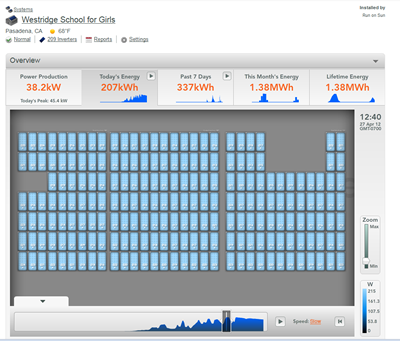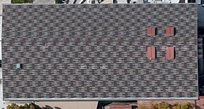Category: "Westridge PAC Project"
06/09/16
Categories: All About Solar Power, Commercial Solar, Residential Solar, Non-profit solar, Westridge PAC Project, Chandler School
Video Release: Making the world better...one roof at a time
Its not every day that we get to unveil a beautifully crafted video showcasing just what it is that makes Run on Sun tick. Happily today is different! Our fabulous distributor, Baywa r.e., has partnered with us to create our very own professional marketing video:
Baywa r.e. has been more than just a products distributor for Run on Sun. We began our partnership with Baywa, formerly Focused Energy, back in 2009 when we found them to be a much more detail oriented operation than their competitors. They proved to us they could translate what happens on the roof to ensuring we got all the pieces necessary to make installations run smoothly. Now, our primary reason for continuing to partner with Baywa r.e. has evolved. Their management and staff all share our vision for a solar industry that is better. One that operates with the highest degree of ethics and transparency and a mission to help consumers save money while reducing our impact on the environment. They have supported us, and other small installers, in many ways far beyond the normal functions of a distributor. Case in point is this video which they produced to help us share our message with our community.
I’d also like to point out a few details on the installations featured in this video:

Lincoln Avenue Water Company Reservoir Project:
This was our second project with Lincoln Avenue after helping their administrative office go solar in 2011. The 2015 Reservoir project was in partnership with Baja Construction building the ground mount structure to support the 246 LG280 watt panels and Enphase M250 microinverters. Run on Sun installed the solar system to utilize otherwise unused land below the reservoir offsetting nearly 50% of the energy required to run their pumphouse.
Westridge School for Girls:

While we didn’t end up shooting video at Westridge we really wanted to be sure to include this project as it is near and dear to our hearts. As Run on Sun’s first school installation and Jim Jenal’s (Founder and CEO) daughter’s alma mater we really enjoyed helping them go solar. In 2012 we installed a solar array on their Performing Arts Center consisting of 216 LG250 watt solar panels which were the cream of the crop back then! Working with Westridge School for Girls was a wonderful experience which included our very own Jim Jenal leading a science class tracking a solar eclipse using the Enphase microinverter data! We believe solar at schools offer such great added benefits providing a resource for students to learn about renewable energy as well as math, engineering, environmental issues and more!

Chandler School:
In the Fall of 2015 we completed the installation of 147 LG300 watt solar panels on the gym at Chandler School. Chandler was also a fantastic partner to work with partially because we share their values in environmental stewardship. We hope that growing up in an educational environment where solar power is the norm will help students navigate a future where sustainable clean solutions will be the only way forward. We would also like to give a huge shout out to the amazing Trevor Spicer, Director of Operations and Information Technology, for the off-the-cuff cameo and kind words in the video.
Residential 14kW Project:

This was the most recent Run on Sun installation featured in the video, where a lot of the dialogue with Jim Jenal takes place. This is the second home these particular clients have installed solar with Run on Sun as they recently moved into this beautiful Altadena mid-century modern home. Their roof was a perfect slate for a solar array, and we wouldn’t be surprised if this particular feature was one reason they chose the property! Owning electric vehicles and wanting to offset as much of their electricity as possible we maxed out the space with 44 LG320’s, top of the line panels today! It didn’t hurt that the view from the roof was one to die for, spanning much of the valley with Los Angeles skyscrapers in the distance. Of course, as evidenced by one of the shots in the video, we could also see the smog levels each day we worked at this site further enhancing our resolve to continue to get more solar out there!
Thanks for reading as we share some of the projects we are most proud of. And of course, let us know if you’d like to get a free quote today and share in our commitment towards the belief that the world can be better one roof at a time!
07/03/13
Categories: Solar Economics, Commercial Solar, Non-profit solar, Westridge PAC Project
Westridge Case Study: Part 3 - Advice to the Solar Reluctant
In Part One of this three-part Case Study we learned how Westridge School chose Run on Sun as their solar contractor. Part Two followed the actual Construction and Installation process from the client’s perspective. Now we conclude with Part 3 - Advice to the Solar Reluctant.
Advice to the Solar Reluctant
A true and long-tenured operations man, Williams understands not every business has the same confidence in the value of large-scale solar installations and their ability to save real dollars. Sometimes, people on the ground are convinced of the legitimacy of solar but may run up against superiors still reluctant to make a long-term investment. To those people, Williams gives this advice:
“Don’t think short term, think big picture,” he says. “Look at the numbers in a way that you’re truly aware of the value of sustainable energy and how important it is.”
 The facilities director advises others in his position to help decision-makers understand having a solar installation is a way to add value to a company and separate a business from competitors in a way that is meaningful to customers. People will likely support that company by continuing to give it business, especially if the cost savings can be passed on to them.
The facilities director advises others in his position to help decision-makers understand having a solar installation is a way to add value to a company and separate a business from competitors in a way that is meaningful to customers. People will likely support that company by continuing to give it business, especially if the cost savings can be passed on to them.
Addressing the upfront costs is one of the biggest challenges, Williams admits, but it’s large-scale projects that offer the best and fastest ROI. When talking to a supervisor, or whoever is responsible for making the decision to invest in a system, speak to the facts. Have your data prepared and on-hand, and be prepared to show concrete evidence that solar would be a worthwhile investment, he says.
Even after a business decides to go solar, there are several more opportunities to remind higher-ups that the decision was a wise one. After installation, data collected from monitoring the system can show the direct benefits to others in the company and create a culture of awareness about the overall benefits of moving toward sustainability. When Williams receives the PWP rebate, he plans to take the paperwork straight to the school’s asset management department.
“Once you estimate the legitimacy of it, don’t let people forget about it. Remind them it’s still working,” he suggests.
‘Surgere Tentamus’
When Westridge School for Girls was first founded in 1913, women were not allowed to vote. Despite that fact, founder Mary Lowther Ranney, a well-known architect and teacher way ahead of her time, envisioned a place where young women could rise to new heights. Today, a full 100 years later, Westridge’s motto, “surgere tentamus,” Latin for “We strive to rise,” says a lot about the legacy of its founder.
The decision to make sustainable improvements to the campus stems from that vision, and in that way, Williams says, the new solar installation is the perfect bridge between the school’s rich founding principles and its desire to bring state-of-the-art green technology to the campus and the classroom.
He acknowledges how fortunate Westridge was to have students and parents who supported bringing solar to campus and were willing to give funds to the school for completion of the project. Now, when students lead group tours, they point to the south-facing roof of the Fran Norris Scoble Performing Arts Center and proudly let visitors know a fully-operational mini-power plant is running, unseen, above their heads.
Williams encourages others in positions like his to research the many potential benefits of solar. Seriously consider the different providers available, and choose the one who can give you the best value for your investment, because quality means more efficiency, more power and more savings.
In his case, he acknowledges his good own good fortune in finding support for solar. “There are a lot of smart people here,” he says. “When you speak intelligently to smart people, good decisions tend to be the result.”
The preceding is an excerpt from Jim Jenal’s upcoming book, Commercial Solar: Step-by-Step, due out this summer.
07/02/13
Categories: PWP Rebates, Commercial Solar, Non-profit solar, Westridge PAC Project
Westridge Case Study: Part 2 - Run on Sun Gets it Done!
In Part One of this three-part Case Study we learned how Westridge School chose Run on Sun as their solar contractor. Here in Part Two we focus on the actual process of the installation as seen from the client’s perspective.
Run on Sun Gets it Done
With the paperwork filed and the rebate secured, Run on Sun had a very tight window — less than two weeks in April 2012 — in which to install and connect all 209 solar modules and get the monitoring software up and running. The goal was for the project to be completed and operational by the time Westridge students returned from Spring break, so time was of the essence.
 For the rooftop display Run on Sun used a microinverter system supplied by Enphase Energy, which allows customers and solar installers to track the output of the modules, individually or collectively, from the convenience of their computers, iPads or smartphones. This software was a selling point for the school, because it would make the technology accessible to students and allow teachers to creatively incorporate aspects of the solar system’s performance into classroom instruction.
For the rooftop display Run on Sun used a microinverter system supplied by Enphase Energy, which allows customers and solar installers to track the output of the modules, individually or collectively, from the convenience of their computers, iPads or smartphones. This software was a selling point for the school, because it would make the technology accessible to students and allow teachers to creatively incorporate aspects of the solar system’s performance into classroom instruction.
The modules were grouped into three sub-arrays that formed a larger circuit. Under each module, a microinverter was installed to convert DC energy gathered from the module into AC power, which could be combined and fed back into the school’s electrical service. The 1:1 ratio of microinverters to modules allows for a more detailed readout that lets users know the output of each module and gives an easy-to-read display should anything ever go amiss, from a connection issue to dirt on the module’s surface.
Throughout the installation Williams remained on hand to oversee the work, though there were no delays and no change orders requesting funds beyond what had been originally estimated. Within the assigned two-week period, Run on Sun had completed the project on time, and everything was in working order.
“I’ve worked with a lot of contractors, and I can honestly say, in this situation, this was one of the most seamless projects we’ve ever completed,” Williams recalls. “They were here early on the first day and, boom, they got it. It was done on schedule, at the price they said and signed off by the city. I wouldn’t hesitate to do a project like that again.”
A Truly Happy Anniversary
April 2013 marked the one-year anniversary of Westridge School’s solar installation, and Williams reports the system is running smoothly. The Enphase software makes it easy for officials, teachers and students to monitor the activity of all 209 modules, but Run on Sun also keeps a close eye on the operations and reaches out if and when an anomaly is detected. In the event that an outage or a decline in energy production should occur, the company promptly notifies the school.
For example, when one of the modules stopped reporting and apparently needed to be replaced, Run on Sun immediately contacted Williams to schedule a visit. The rest of the modules were still in full working order, and upon close inspection it was revealed that a connection had come loose. Still, to ensure maximum performance, the company replaced the microinverter at no cost to the school.
Another time Williams received a notification email from Run on Sun after the campus Internet connection had been temporarily cut during some service upgrades. And when the energy dipped from its norm of exceeding system predictions to 98 percent of anticipated, a call came in with a recommendation to check the array for accumulated dirt. After a brief spray with a hose, the system was back to producing at maximum capacity.
At the one-year mark, the school became eligible to receive its first annual rebate from Pasadena Water and Power. This is the first of five annual rebates it will receive, the dollar amounts directly correlated to the system’s actual production.
When a technician came from the city to assess the energy output of the system, the school was excited to learn the results. The city’s readings gave some very welcome news, indeed — the energy generated by the installation was above and beyond the original estimate provided to PWP, and it looked like the first rebate would be larger than anticipated.
“He said, ‘You’re over your estimate,’ and that’s all we could ask for,” says a thoroughly pleased Williams. “To date, everything that was promised to us was delivered — plus.”
In terms of the amount of energy generated, the rooftop system has continued to outpace expectations. The school expected to see a return on its investment in seven years, but it’s shaping up to come in as few as six. Because of the installation, Westridge is using 30 percent fewer kilowatt hours and is seeing its bills reduced by thousands of dollars each month, in addition to the rebate. The overall savings is far greater than the cost of running the air-conditioner in the gym, the initial impetus for bringing solar to campus. To Williams, making the decision to go solar was a “no-brainer.”
“The neat thing about this is it runs itself. If somebody walks onto campus, they don’t know we have a 52 kilowatt solar system on campus,” he adds. “They don’t see it. It doesn’t impact anything. All you do is save money.”
We will conclude this three-part Case Study with Part Three - Advice for the Solar Reluctant.
The preceding is an excerpt from Jim Jenal’s upcoming book, Commercial Solar: Step-by-Step, due out this summer.
07/01/13
Categories: PWP Rebates, Non-profit solar, Westridge PAC Project
Case Study: Westridge One Year Later
Today we begin a three-part series offering a Case Study of the Westridge project, one year later. Part One reviews the process that Westridge used to choose the solar contractor to build its solar project. Part Two details the actual construction and the experience of the School in managing the project. Part Three concludes with some advice to the Solar Reluctant on why solar really does make sense.
For the past 100 years, Pasadena’s Westridge School for Girls has prided itself on providing a top-notch education that grooms young women into the leaders of tomorrow.
As part of a legacy of bringing cutting-edge ideas and innovation to campus and making it all come alive in the classrooms, school officials have made it a goal to pursue and complete at least one project related to sustainability on campus each year.
In late 2011, looking forward to the next year, they decided to address a perennial request made by parents and students over the years: that an air-conditioning system be installed in the school gymnasium to keep crowds cool on hot days. While the school could likely raise funds from the parent community to purchase and install a system, the financial and environmental impact of running it and creating a new drain on the power supply were less than sustainable, says Brian Williams, Westridge’s Director of Facilities.
So, to offset the cost and energy consumption of the desired air-conditioning unit, officials decided to fundraise for another project at the same time, one that would mitigate the cost and consumption of the A/C.
They asked parents and students if they’d be willing to raise money to install a solar system on school grounds.
Big Plan on Campus
Solar energy was not exactly new to the school. In 2009, Westridge had installed a small system on its newly built LEED-Certified Platinum science and math building. There some of the panels were placed near the ground, where students could see them up close and interact with the technology.
For the new project, however, school officials were thinking much bigger. They wanted to maximize energy savings by installing a large-scale system that would provide a solid and swift return on their investment and take advantage of a local rebate being offered by Pasadena Water and Power (PWP) that was set to decrease drastically after the end of the year.
Ideally, the new installation would generate enough energy to cover the usage from the A/C in the gym and still supply additional power to other buildings on the campus, saving on the school’s overall monthly electric bill. At the outset, there were no specific parameters for the project, Williams said, just a location.
“We found our biggest roof and said, ‘Fill it up,’ he says.
The south-facing slope of the roof of the Fran Norris Scoble Performing Arts Center would be the perfect place to set up a large installation. With an area of approximately 4,000 square feet, it received direct sunlight throughout most of the day and was elevated enough to tidily keep the operation out of sight.
Doing their Bidding
Williams turned to three different solar companies, seeking estimates to help define the scope of the project and determine a total cost that would guide the school’s fundraising efforts.
The first two companies Williams considered were those the school had worked with on past projects. One was a large, international solar provider that had worked on the 2009 science building installation. The other had previously worked with Westridge on nearby residential properties.
Run on Sun, the third provider approached regarding the installation, was the only one the school had not personally worked with before. The Pasadena-based company had contacted school officials earlier that year and delivered a presentation on its installation process, qualifications and services provided. That presentation was fairly comprehensive, and made enough of an impact for Westridge to include Run on Sun in the bidding process.
“We didn’t have any actual experience with them, but they had very good references that we checked as we went through the bidding process,” Williams explains.
Finding the right contractor for the job was a thorough search that employed analysis and research. But beyond that, Williams, who’s worked in the facilities department for more than two decades, relied on his own gut instinct and experience to determine which company could best get the project done in a short amount of time and leave no detail unchecked.
Since Westridge is a privately funded nonprofit, it is not under the same obligation as public entities to accept the lowest contractor bid. Cost, however, was still a primary consideration in selecting an installer.
“I have a fiduciary responsibility in my job to make sure the projects we do here are cost-effective and help maintain our campus in a positive way,” Williams says. “I can’t do anything that doesn’t make fiscal sense.”
The cost estimates provided by the three companies for an approximately 50 kW system were not that disparate from one another, coming in at about $4.25 per watt. One thing Westridge did have to be cautious about in its review of the estimates, however, was the possibility of a provider initially underbidding the project with the intention of requesting additional funds through change orders after a contract had been signed. The contractor who was truly right for the job would be one who provided an accurate estimate up front and diligently held true to that figure.
When considering the PWP rebate, Williams knew the school stood to save about half the total cost of the installation over the course of five years. Additionally, all three bidders told Westridge officials they could expect to see a full return on their investment in about seven years. Overall, the project made great financial sense.
Since the cost estimates that came in from the three bidders were relatively similar, Williams also analyzed each company’s references, experience and credentials. For example, he did consider installers certified by the North American Board of Certified Energy Practitioners (NABCEP) to have an advantage over uncertified companies. Another important factor was the presence of a licensed electrician on the staff. “It’s an electrical installation, and I wouldn’t let anybody who wasn’t a licensed electrician be on site,” he says. “I’m guessing the city wouldn’t allow it either.”
Throughout the selection process, Westridge officials knew they were working under a bit of a time crunch. If they missed the window to apply for the PWP rebate, the project would end up costing significantly more than the amount they had raised. Because of this, hiring an installer who could successfully submit all the paperwork before the fast-approaching deadline, and one they could trust to get the application process 100 percent right the first time, was of critical importance.
In this regard, Run on Sun was a standout, Williams says. They promised to take care of all the paperwork, filing within the deadline period and eliminating the extra bureaucratic steps the school would otherwise have had to take.
“They managed the whole process — I basically [just] had to sign the form,” he says.
The fact that Run on Sun had a strong working relationship with the city of Pasadena was another important consideration that worked in its favor, given Westridge’s own solid standing in the community. The attention to detail and professional accountability demonstrated by the company throughout the bidding process brought the local provider to the top of the list, making the ultimate decision to go with Run on Sun an easy one, Williams says.
“It was a combination of the cost, return on investment, their relationship with the city, the impression we had with the provider, how they presented the information and their references. We looked at all of it.”
Next up, Part Two - Run on Sun Gets it Done!
The preceding is an excerpt from Jim Jenal’s upcoming book, Commercial Solar: Step-by-Step, due out this summer.
08/22/12
Categories: Commercial Solar, Westridge PAC Project
Enphase Features Run on Sun and Westridge School for Girls
We have written at some length about Enphase micro-inverters in the past, but today Enphase returned the favor. Here was the lead story in their Summer 2012 Newsletter that just went out this morning:
That is Run on Sun Founder & CEO, Jim Jenal, posing amidst our solar installation at the Westridge School for Girls here in Pasadena. The article quoted Jim and provided a link back to our video highlighting the Westridge installation. Pretty cool.
Even cooler, however, was the meeting that we had this week with Mark Abrams, the Director of Product Management for Enphase. We met with Mark to provide him with feedback about their existing products and to offer our insights about their next generation product that is still in prototype. This was a great exchange - we told Mark what we loved about their products - but also important ways in which the product could be improved, at least in the eyes of an installer! Mark listened intently, took notes, and promised to see what he could do to incorporate our feedback.
It is hard to over estimate the value of such interactions between manufacturers and installers, yet it doesn’t seem to happen as often as it should. So here’s a note to the rest of the manufacturers out there - if you really want to improve your products, start spending (more) time with installers, and I don’t mean your sales people. (Trust me, we already get more than enough contact from your sales reps.) You might not like everything that you hear, but learning first hand what our problems are is the best way to build a long-lasting relationship with the folks who are the most important to your long-term success.
After all, that might be Jim’s face that you see in that photo, but it’s Enphase’s products that made that project a reality.






